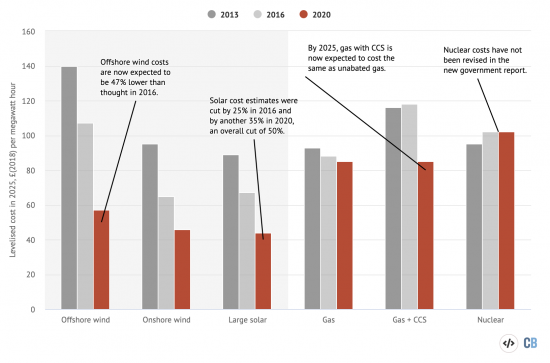The government has just revised its official estimates of the cost of electricity generation, again. According to Carbon Briefing these are the new estimates, with some old data for comparison:

But still they don't want to place the emphasis on renewables.
And it's still carbon capture and storage and nuclear that are out supposed lifelines.
Politely, no, they're not.
We need a Green New Deal.
Thanks for reading this post.
You can share this post on social media of your choice by clicking these icons:
You can subscribe to this blog's daily email here.
And if you would like to support this blog you can, here:



The only way gas can cost the same as gas + CCS is if the CCS doesn’t actually happen. Looks like more dodgy accounting is the plan then. If only the climate could be fooled by accounting trickery.
Logically, that’s right
CCS won’t happen…
The BEIS paper on which the article is based can be downloaded here. https://www.gov.uk/government/publications/beis-electricity-generation-costs-2020
I have been through it & indeed, it shows RES much cheaper than fossil. The entertainment starts towards the end where the paper starts a discussion on costs for system integration of RES. It then compares RES+system integration costs vs fossil+CCS (mostly gas-powered CCGTs). The result is, amusingly, predictable.
However, the problem BEIS faces is that more RES on any system drives down wholesale prices. Adding Fossil+CCS to the generation mix makes not a blind bit of difference to this reality. The only way out of this is large-scale dispatchable load, step forward electrolysers (there is nothing else that is dispatchable, at scale (GW) over multi-day periods – demand response mostly works over 24hrs periods – not multi day – yes there are some exceptions – emphasis on “some” but not such as to make a difference).
I don’t blame BEIS for their approach – they are fossil & nuke fan boys at heart. However, their approach locks UK citizens (serfs?) into paying for elec twice: once for the energy-only bit (which more than covers levelised costs for any RES-tech you care to chose) and a second time for the subsidy in this case the CfD element needed to bridge the gap between low wholesale (which RES causes absent large dispatchable load) and CdF bid prices. BEIS, like WW1 generals, have “formed a view” – & the outcome of this view is that UK cit-serfs pay more for elec. Look on the bright side – at least it’s not dead people.
In terms of “why” – there is a rotating door running between the fossil-mob, nuke-mob and BEIS. Thus, what you see is a fossil/nuke view dressed up as UK gov view. Although, as already noted the numbers at the start are not bad & accord with those out in the real world – exception is Page 10 – PV Table 2.1 where it is clear a “damage limitation exercise” has taken place wrt the numbers for 2025 2030 etc. We started sniggering at this point cos it’s clear, given what’s coming down the PV tech track that PV will get very cheap indeed . But hey! – when the conclusions are already written – we can’t have facts spoling the outcome. UK citizens deserve better.
Thanks Mike
Thanks, Mike
I know we expect obfuscation (or should do) but it is always helpful to have contributions from those who know how these things ‘work’
By electrolysers, I guess you mean producing hydrogen? If so, does that mean we might not have to replace gas boilers with ASHP? In my view ASHP is a disaster for the average household since I cannot see effective insulation getting installed sufficiently well in a relatively short timescale.
Also (sorry!) are we any nearer to having large scale tidal or wave power?
Thanks!
As a Gas Safe registered engineer, I totally agree with your comment about insulation.
Unless and until this country gets behind insulation standards similar to Passivhaus which require mechanical ventilation & heat recovery, then we are doomed to keep natural gas heating.
All the renewable heating systems are only really effective (cost/environmentally/take your pick) when our houses are no longer built to stupid standards.
But for that to happen, the house builder lobby needs to be broken and the actual builders need to be properly trained.
Hi, Mike. Couple of points. Firstly, electrolysers need power. Meaning go back to Go. To get “green hydrogen” you need renewables to power them, otherwise you’re no further forward. It is the way to go,, but the cost of such H2 power is still expensive and we’d need a shedload more renewables installed to achieve that, as well as the electrolysers, storage etc.
Secondly I don’t think there’s any direct “collaboration“ between the nuke and oil & gas industries. Gas produced through “net zero” extraction methods and energy from gas fired stations incorporating CCUS is basically carbon neutral. Scotland has a massive oil & gas industry that we simply can’t, nor need to, walk away from, at least in the short term.
Too true.
What’s truly stunning about the report is that they now expect offshore wind to become cheaper than onshore wind by the mid-2030s. (due to much larger turbine sizes 20 MW + better wind conditions).
I remember BBC Panorama back in 2011 decrying offshore wind as being “eye-wateringly expensive” and moreover that it would only become more so. The programme title was “What is really fuelling energy bills in Britain?” and was the worst low-grade ‘Daily Mail’ type reporting aimed at scaring UK voters off zero carbon wind energy. Not the BBC’s proudest moment.
http://news.bbc.co.uk/panorama/hi/front_page/newsid_9631000/9631864.stm
Stephen,
Thanks for the link to the BBC Panorama programme. While the link to the video itself did not work for me, the accompanying text reveals that it was analysts at those completely trustworthy and not at all biased organisations KPMG and Citigroup who advised the government to scale back plans for offshore wind in order to save money. One day historians will reveal why so many of the decisions made by our elected representatives rested on advice from unaccountable and overpaid beancounters.
Great website Richard – thanks
Rick
The KPMG report failed to take account of the cost reduction that would take place if offshore wind was allowed to develop at scale. And that scale is only being achieved because of the initial government support that kick-started the process.
The costs of producing green hydrogen by electrolysis will also fall significantly, but again only if there is the initial government support.
The contrast with nuclear is stark – the more the government supports it, the more the costs rise.
Thanks for all the comments. What follows tries to clarify a couple of things coming out of the comments.
1. distribution networks in urban & sub-urban areas can only support a penetration of ASHPs up to circa 30%. After that things go pear shaped. (I’m an ex-DNO engineer). We have modelled this.
2. We have modelled, thermally, houses & their heat demand. Modern double or triple glazing, 240mm loft insulation and high performance wall insulation will more than half heat demand. If you go the ASHP route you have to do that. If you want to convert from nat gas systems to hydrogen with boilers or fuel cells, you have to do that. Houses with high thermal performance are not a choice, they are a requirement wrt de-carb.
3. Cost of Green H2 is covered in website http://www.greenh2foreurope.eu but in summary: there are two low/zero carbon systems to produce H2: SMR+CCS with nat gas as the feed stock and renewables and electrolysers. SMR+CCS has yet to be built at a scale that sequesters 90% CO2. But recent tech reports indicate that the two systems are broadly speaking, comparable in the cost of the H2 they produce. But: SMR+CCS does not solve the problem of the need for large-scale dispatchable load when you have lots of renewables, electrolysers do. I rest my case. by the way: SMR production HAS to be de-carbed – e.g. just for fertiliser production alone, H2 production using nat gas as the feedstock accounts for 44 mega tonnes of CO2/yr in the EU.
Defending the bean counters: my guess is that they cooked up the numbers that gov wanted. It’s no better with respect to the European Commission & the morons they give contracts to. For the avoidance of doubt the last paid work I did for the EC was around 18 years ago & I have zero plans for any paid work ever again. That does not mean I don’t work with the Commission – operative word “with”.
Thanks Mike
Thanks again, Mike.
I can echo that. I find your comments really helpful
Hunterston B is closing two years earlier than planned, in 2022; I wonder how that changes things (both in a Scottish and UK context)?
It means the full decommissioning cost now has to be paid by EDF
Mike,
Thanks for an interesting take on the BEIS report. Because of your background, I wonder if you have a view on the desirability or otherwise of new housing developments to be equipped with a 3-phase supply to each home. I saw a recent ‘Fully Charged’ featuring Parc Eirin where the argument was made for each new home having 3-phase in terms of rapid charging of EVs. This would supposedly allow motorists to top up after getting home from work, and be ready to go out again shortly afterwards. A more likely reason seemed to be that it would allow the energy managers for the development to sell grid services by facilitating bigger power swings for demand response. I noticed that Western Distribution are treating Parc Eirin as a pilot study.
It struck me that one could argue that well insulated homes should not need powerful heat pumps and that most EVs will have big enough batteries to deal with evening journeys, or they will charge slowly over night or simply augment with a visit to the local rapid charger if necessary. Also, neighbours might buy and sell from each other in a peer-to-peer manner in future, rather than exchanging large flows of energy with the grid. Will domestic demand response be a feature of a future smart grid or should we leave this to bigger industrial users? Should the UK move to 3-phase domestic supply in the interests of future-proofing, as the REA has been arguing?
Rick